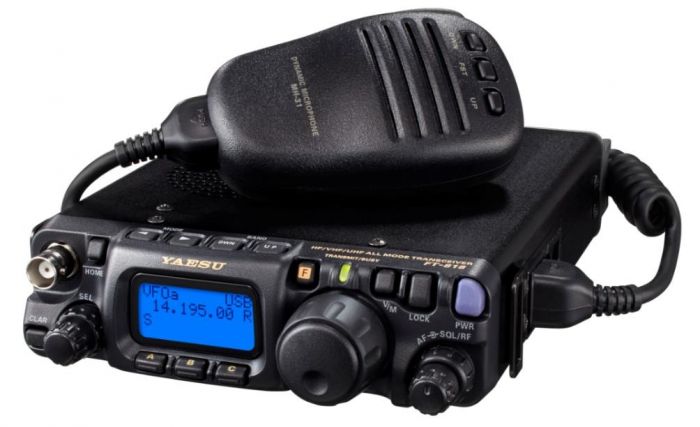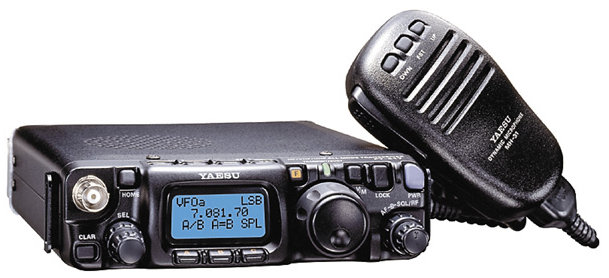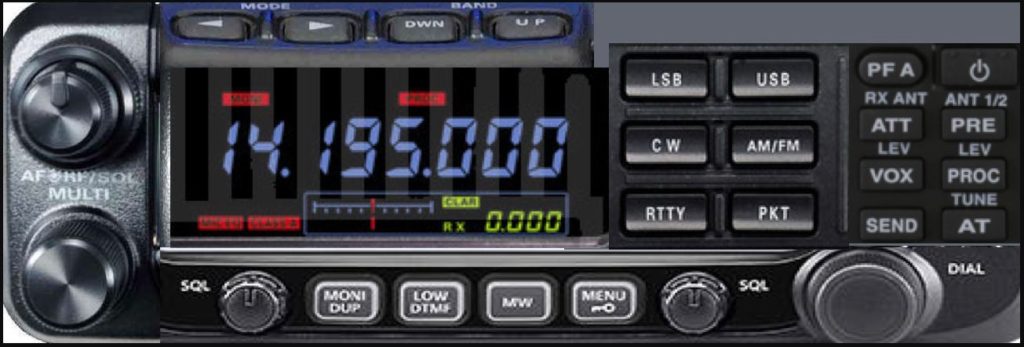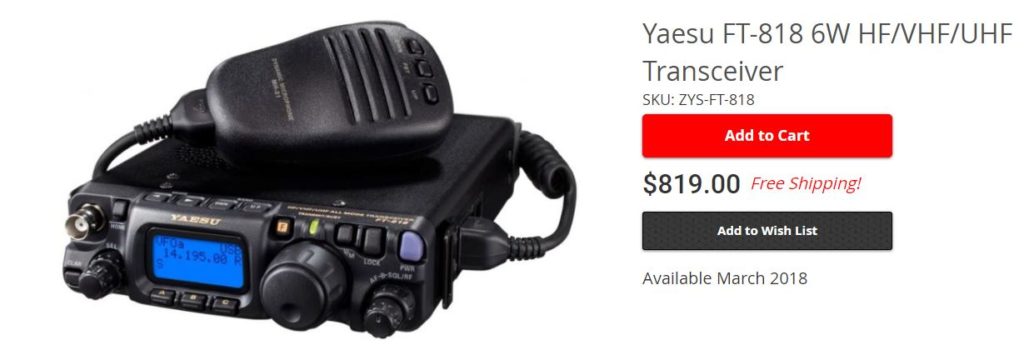I’ve been following news about the Yaesu FT-818: the next iteration of the venerable Yaesu FT-817ND QRP general coverage transceiver.
The FT-817 series has been on the market for nearly two decades. I remember purchasing one of the first production models when I lived in the UK in 2001.
It was a revolutionary radio at the time.
It was exceptionally suited for portable use, sporting an internal battery pack, on-board keyer, had all mode/all band capability and antenna ports on the front faceplate and rear. It was the most compact full-featured transceiver on the market. All this for about $670 US.
In 2004, Yaesu made upgrades and launched the model FT-817(N)D. In no small way, I’m sure this little radio has been a cash cow for Yaesu. It’s had an exceptionally long market run and has been the only QRP transceiver in the Yaesu product line for decades.
Recently, Yaesu released specifications and retail pricing of the FT-818. But before we go any further…
Don’t believe the fake prototype photos
It seems like every time a new amateur radio transceiver is announced, someone quickly assembles a “leaked” prototype image and publishes it on the web. Here’s the one someone pieced together for the Yaesu FT-818:
To be crystal clear: this is not a leaked photo of the Yaesu FT-818. It’s (frankly) a terrible Photoshop job–someone playing with cutting, pasting and resizing bits from other transceivers.
I fully suspect the new FT-818 will not be a dramatic departure from the FT-817 in terms of styling and design. Perhaps it’ll be nearly identical. In fact, radio retailers have been posting the following image on their FT-818 ordering page:
This may simply be a placeholder, or it may be that all of the upgrades are internal and the ‘818 form factor will be identical to the ‘817.
Enough said…
What we do know about the Yaesu FT-818
Rumors of an FT-818 have been floating around the ham radio community for years. No surprise given the extraordinarily long run of the ‘817 series!
We do have concrete details now since ham radio retailers have been given features, specifications and availability dates. It appears the upgrades are iterative–this is not a dramatically re-designed rig.
Here’s what Yaesu has released (I took this from GigaParts, but retailers are posting variations of the same announcement):
Yaesu FT-818 6W HF/VHF/UHF All-Mode Portable Transceiver
The new Yaesu FT-818 incorporates all of the basic and attractive features of the ever-popular FT-817ND while providing upgrades desired by many existing owners.
The FT-818 provides 6W of solid output power with an external DC power source. The supplied Ni-MH battery pack (SBR-32MH) has been upgraded to now provide larger battery capacity – 9.6v/ 1900mAh. The recent launch of several new satellites is a certain indicator that the large global community of satellite enthusiast are going to be very delighted to learn that the FT-818 includes a Built-in TCXO-9 oscillator that gives the FT-818 fantastic frequency stability (±0.5ppm).
The FT-818 includes all the useful functions that are included in the FT-817ND: Dual VFOs; Split-Frequency operation; IF Shift; Clarifier “R.I.T”; IF Noise Blanker; RF Gain and Squelch control; IPO (Intercept Point Optimization); AM Aircraft reception; AM and FM Broadcast reception; VOX; Built-in Electronic Keyer; Adjustable CW Pitch; Automatic Repeater Shift (ARS); Built-in CTCSS Encoder/ Decoders; 208 memory channels with 10 memory groups; two antenna connectors; Automatic Power-Off (APO) and Time-Out-Timer(TOT) functions; and so on.
Features
- Increased power output 6W(SSB, CW, FM) 2.0W(AM Carrier) *NEW!
- Improved frequency stability ±0.5 ppm : Built-in TCXO-9 *NEW!
- Larger battery capacity : 9.6V/1,900mAh (SBR-32) *NEW!
- 208 Memory Channels / 10 Memory Groups
- Operates on 160-10m , HF, 6m, 2m and 70 cm Bands
- Ultra Compact and Portable
- Two Antenna Connectors
- IF Shift, IF Noise Blanker, IPO, ATT
- CW “Semi-Break-in”, CW Reverse, CW Pitch Control
- Built-in Electronic Keyer
- Multi-Color Easy to see LCD
- Internal Battery Operation Capability
- ARS Automatic Repeater Shift
- APO Automatic Power Off
- Front Panel Key Lock Mode
Specifications
Frequency Ranges:
RX:
- 100 kHz – 33 MHz
- 33 MHz – 56 MHz
- 76 MHz – 108 MHz
- 108 MHz – 154 MHz
- 420 MHz – 470 MHz
TX:
- 1.8 MHz – 29.7 MHz (5.3320 MHz/ 5.3480 MHz/ 5.3585 MHz/ 5.3730 MHz/ 5.4050MHz)
- 50 MHz – 54 MHz
- 144 MHz – 148 MHz
- 430 MHz – 450 MHz (Amateur Bands only)
Circuit Type: Double-Conversion Superheterodyne (SSB/CW/AM/FM)
Single-Conversion Superheterodyne (WFM)
Modulation Type: A1A(CW), A3E(AM), J3E(LSB,USB), F3E(FM), F1D(PACKET), F2D(PACKET)
RF Power Output : 6 W (SSB/CW/FM), 2 W (AM Carrier) @13.8 V
Memory Channels: 208
Case Size(W x H x D): 135 x 38 x 165 mm (5.31″ x 1.5″ x 6.50″) w/o knob and connector
Weight: 900 g (1.98 lbs) (w/o Battery, Antenna and Microphone)Includes
- Yaesu FT-818 6W HF/VHF/UHF All-Mode Portable Transceiver
- Hand Microphone(MH-31A8J)
- Battery (SBR-32 9.6V 1900mAh Ni-MH )
- Battery Case (FBA-28) (Requires 8 “AA: batteries)
- Whip Antenna for 50/144/430 MHz (YHA-63)
- DC Cable (E-DC-6)
- Shoulder Strap, Ferrite Core, Rubber Foot
- Operating Manual
- Battery Charger (PA-48)
The retail price is roughly $819 US shipped via GigaParts and $849 via Ham Radio Outlet. I’m sure Universal Radio will post the FT-818 to their site soon as well. At time of posting, I haven’t noticed any retailers outside the US including the FT-818 in their catalog.
I will plan to review the Yaesu FT-818, so bookmark this tag to follow any updates: Yaesu FT-818





I own a FT-817nd, and was mildly interested in the FT-818, but the things I wanted fixed, are not in the formal announcement.
1). No mike limiting in the mic-amp stage. This is what causes the overdrive when you try to use an MH-36 (which is an official Yaesu option).
2). Turn off the ALC in AM-Carrier mode. Then recalibrate the radio accordingly. Since the carrier is always twice the amplitude of either sideband, in the composite signal, the ALC attacks the carrier, and unbalances the proper construction of an AM-Carrier signal. The poor signal quality problem has been a complaint for decades, and has never been fixed.
3). Redesign the battery charge circuit to operate as an automatic charger, and remove the clock-timer, while including lithium-battery charging in the mix. This is not hard, and would cost minimal money to include the altered firmware.
4). Get rid of all the ceramic filters, and default wverything to decent mechanical filters. This would mean, that Yaesu would have to buy the patents, trade secrets, and construction jigs; from Collins Radio. But this, in the end would lower the cost of decent filters, for everything in the Yaesu low to medium grade lines, and they could then sell them to other makers. This would be a great way for Yaesu to make a buck and lower production costs in a win-win decision. Collins would love to sell this stuff cheap, as they have discontinued all production as of the end of 2017.
I won’t be buying an FT-818 anytime soon because my FT-817 is quite literally the same thing. So why hasn’t Yaesu “upgraded” the so-called old technology in this rig? The answer is simple – they don’t need to. The FT-817 is a proven simple and very reliable radio and does not need to be “upgraded” at all. It just works. No multiple overcomplicated processors & gobs of DSP junk which doesn’t really work as well as advertised. The FT-817 has (1) microprocessor and only enough firmware to make it work well. I also have a new, state-of-the-art FT-891 and it is SO different from the FT-817 and not in a good way either – i.e. (3) microprocessors each with associated firmware, Tons of unneeded menu options, lousy and dumbed down interface. Takes many milliseconds just to boot up!
My FT-817s have never let me down, and there are more than a few original non-nd model FT-817s out there which have been working since 2000-2001. I really doubt that the FT-891 and other such radios will last that long.
The FT818 is really an FT817 + larger battery pack and TXO, the power output has been 6 watts for past few years when the PA module was replaced by FETS, I have had one since Jan 2017, it does 5MHz as standard etc etc……Checkout the Yaesu dealer in Athens, he has sold 75 during the past year!
The Yaesu rep on the FB group said that the FT-818 came about because too many parts for the 817 were getting difficult to source, and there were enough changes that the FCC made them recertify the radio.
He didn’t hint at a ‘real’ upgrade coming any time soon.
The retail price of the FT-818 is too close to the street price of the still manufactured (but for how long?) FT-857 so I’m sure the retail price will end up being down near where the current FT-817 is selling. Yaesu isn’t dumb and they know they need to create some daylight between the pricing on the two radios to give customers a reason to choose the FT-818 over the FT-857 (and a $13 TXCO module isn’t gonna’ entice anyone). Previous comments about the 817’s lousy 15 year old battery management design are spot on – here’s hoping Yaesu has incorporated new power management circuitry to reduce the troublesome ‘drain-down’ issue. Like so many FT-817 owners I opted to just use NiMH AA cells in the battery tray to get away from the battery drain-down, but that comes with its own potential issues – no fuses on the battery tray power leads can mean a damaged radio if the batteries are inserted improperly in the tray.
If the 818 is just an upgraded version of the 817, then the really interesting issue is what Yaesu has done about the IF filters. The 817 uses mechanical filters as the main selectivity element and those are no longer manufactured by Rockwell Collins.
Today, it would be a lot easier and cheaper to design SDR architecture.
The talk is about optional Collins mechanical filters. From what I’ve read, it’s not clear if the rig has mechanical filters as standard, leaving me to suspect ceramic filters, though surly fairly good ones.
The TS830 use ceramic filters, with space for optional mechanical filters. So I suspect the Yaesu is the same.
But yes, the option is likely gone now, unless one can scrounge a mechanical filter of the correct size.
Of course, Collins stopped making them because demand had dropped, companies going to DSP, which also allows more bandwidths without extra cost. Thus why they aren’t going to DSP here is probably a question, though maybe it means the skimpy advanced information simply doesn’t mention it.
Michael
The most important feature that is missing from the spec: A power drain from the battery in the OFF state in the µA range. As it is you can be sure that the battery pack is either depleted or even damaged when you need it. Therefore I still insert 8 AA cells or use an external power supply.
These days it should be no problem to use an 8-pin microprocessor that watches out for the power key and the APO (automatic power-off) feature. Add a single transistor that cuts off the rest of the electronics in the OFF state.
I simply wonder how Yaesu can still produce a 20 years old design. Many key components should have been out of production for 10 or 15 years.
“Many key components should have been out of production for 10 or 15 years.”
And THAT is the KEY reason for this awful unimaginative re-hash. They are simply trying to keep the old 817 production line running with minimum disruption, and at minimum cost.
Really struggling to see why this would be worth over $800. Did anyone at Yaesu actually do some leg work and look at what is available for under $1000 in the QRP radio market?
If these specifications are correct, Yaesu phoned this one in. Battery capacity/chemistry is pathetic and the receiver architecture seems to be firmly stuck in the late 90’s. These guys couldn’t even make the VHF extended receive go up to 174 MHz?
Between the various Chinese rigs and the offerings from Elecraft, LNR, and countless other kits, Yaesu has to know that having a battery pack and a shoulder strap isn’t going to be enough for this to sell like the 817. I guess they have the nostalgia and YouTube factor to count on.
I wish Icom would think about a QRP rig. I have no doubt they could crush designing a radio similar to the 703/706 but with an SDR receiver and much better power consumption. Sell a matching backpack like the 706 had available and they would have a guaranteed hit.
Kinda meh…Seriously, no US Weather band?
I don’t see anything yet on:
Built in USB
Lower receive power drain
Better receiver
DSP noise reduction
DSP Speech Compressor
The -818 showed up on Universal’s website https://www.universal-radio.com/catalog/hamhf/0818.html with an expected arrival time in March.
I wonder if this announcement will mean existing stocks of -817’s will be discounted?
Brett W3SWL
If it’s not fake then I am pleased.
But to me this is NOT the way to go about marketing things properly.
Leaving it to the gossip mill to do the job of Yaesu’s PR is pretty poor, they
should bow their heads in shame forbeing so unprofessional.
But then maybe there’s an another side to this.
THe 818 offers such a huge upgrade compared to the 817.
Yeah, a slightly less crappy battery capacity, that still won’t allow proper 5w operation,
a $10 high stability txco module.
No wonder Yaesu’s marketing people couldn’t be bothered to get out of bed and
do some marketing 😉
You know usually a manufacturer makes an announcement
at Dayton or Friedrichshafen.
Or even puts something on their official website.
I think this is just another load of crap.
Oh no, I can assure you that the FT-818 is a reality. Yaesu wants the radio to start shipping and well into production prior to Hamvention/Friedrichshafen. Yaesu plans for retailers to have stock in just a few weeks (March).
What isn’t real is the fake photo. 🙂